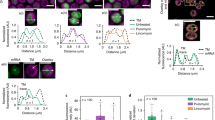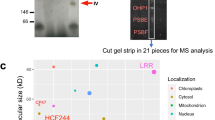Abstract
Transmission electron microscopy and immunocytological labeling were used to localize the 32-kilodalton (kDa) protein (DI polypeptide) of photosystem II in different cell types of the cyanobionts within leaf cavities ofAzolla caroliniana Willd. The 32-kDa protein binds the secondary electron acceptor QB, and is highly conserved between plants and cyanobacteria. Three antisera, specific for different epitopes of the 32-kDa protein, were used as primary antibodies. Immunologically recognizable 32-kDa protein was localized on membranes ofAzolla chloroplasts, vegetative cyanobacterial cells, akinetes, and heterocysts that were at all stages of the differentiation process. The 32-kDa protein was not detected in nonphotosynthetic endosymbiotic bacteria found within leaf cavities. The amount of the 32-kDa protein observed in different cyanobacterial cell types was dependent upon the primary antiserum used and membrane orientation within a cell with respect to the plane of sectioning. Therefore, although 32-kDa protein was present in all three cyanobacterial cell types and clear trends in labeling patterns could be elucidated, it was not possible to quantitate the amounts of protein with respect to either cell type or leaf-cavity age.
Similar content being viewed by others
Abbreviations
- Ab:
-
antibody
- kDa:
-
kilodalton(s)
- PSII:
-
photosystem II
References
Adams, D.G., Carr, N. (1981) The developmental biology of heterocyst and akinete formation in cyanobacteria. CRC Crit. Rev. Microbiol.9, 45–100
Alberte, R.S., Tel-Or, E., Packer, L., Thornber, J.P. (1980) Functional organization of the photosynthetic apparatus in heterocysts of nitrogen-fixing cyanobacteria. Nature284, 481–483
Allen, M.M., Turnburke, A.C., Lagace, E.A., Steinback, K.E. (1983) Effects of photosystem II herbicides on the photosynthetic membranes of the cyanobacteriumAphanocapsa 6308. Plant Physiol.71, 388–392
Almon, H., Böhme, H. (1980) Components and activity of the photosynthetic electron transport system of intact heterocysts isolated from the blue-green algaNostoc muscorum. Biochim. Biophys. Acta592, 113–120
Arntzen, C.J., Darr, S.C., Mullet, J.E., Steinback, K.E., Pfister, K. (1982) Polypeptide determinants of plastoquinone function in photosystem II in chloroplasts. In: Functions of quinones in energy conserving systems, pp. 443–452, Trumpower, B., ed. Academic Press, New York
Becking, J.H. (1987) Endophyte transmission and activity in theAnabaena-Azolla association. Plant Soil100, 183–212
Becking, J.H., Donze, M. (1981) Pigment distribution and nitrogen fixation inAnabaena azollae. Plant Soil61, 203–226
Bergman, B., Lindblad, P., Rai, A.N. (1986) Nitrogenase in freeliving and symbiotic cyanobacteria: immunoelectron microscopic localization. FEMS Microbiol. Lett.35, 75–78
Bradley, S., Carr, N.G. (1971) The absence of a functional photosystem II in heterocysts ofAnabaena cylindrica. J. Gen. Microbiol.68, xiii
Braun-Howland, E.B., Nierzwicki-Bauer, S.A. (1990) Biochemistry, physiology, ultrastructure and molecular biology of theAzolla-Anabaena symbiosis. In: Handbook of symbiotic cyanobacteria, pp. 65–117, Rai, A.N., ed. CRC Press, Boca Raton, Fla., USA
Braun-Howland, E.B., Lindblad, P., Nierzwicki-Bauer, S.A., Bergman, B. (1988) Dinitrogenase reductase (Fe-protein) of nitrogenase in the cyanobacterial symbionts of threeAzolla species: Localization and sequence of appearance during heterocyst differentiation. Planta176, 319–332
Bühler, T., Sann, R., Monter, U., Dingler, C., Kuhla, J., Oelze, J. (1987) Control of dinitrogen fixation in ammonium-assimilating cultures ofAzotobacter vinelandii. Arch. Microbiol.148, 247–251
Curtis, S.E., Haselkorn, R. (1984) Isolation, sequence and expression of two members of the 32 kDa thylakoid membrane protein gene family from the cyanobacterumAnabaena 7120. Plant Mol. Biol.3, 249–258
Donze, M., Haveman, J., Schiereck, P. (1972) Absence of photosystem 2 in heterocysts of the blue-green algaAnabaena. Biochim. Biophys. Acta256, 157–161
Fay, P., Cox, R.M. (1967) Oxygen inhibition of nitrogen fixation in cell-free preparations of blue-green algae. Biochim. Biophys. Acta143, 562–569
Golden, S.S., Haselkorn, R. (1985) Mutation to herbicide resistance maps within the psbA gene ofAnacystis nidulans R2. Science229, 1104–1107
Golden, J.W., Robinson, S.J., Haselkorn, R. (1985) Rearrangement of nitrogen fixation genes during heterocyst differentiation in the cyanobacteriumAnabaena. Nature314, 419–423
Goloubinoff, P., Brusslan, J., Golden, S.S., Haselkorn, R., Edelman, M. (1988) Characterization of the photosystem II 32 kDa protein inSynechococcus PCC7942. Plant Mol. Biol.11, 441–447
Haselkorn, R., Curtis, S.E., Golden, J.W., Nierzwicki-Bauer, S.A., Robinson, S.J., Tumer, N.E. (1984) Organization and transcription ofAnabaena genes regulated during heterocyst differentiation. In: Molecular form and function of the plant genome, pp. 443–453, Van Vloten-Doting, L., Groot, G.S.P., Hall, T.C., eds. Plenum Press, New York
Herdman, M. (1987) Akinetes: structure and function. In: The Cyanobacteria, pp. 227–250, Fay, P., Van Baalen, C., eds. Elsevier, Amsterdam
Hill, D.J. (1975) The pattern of development ofAnabaena in theAzolla-Anabaena symbiosis. Planta122, 179–184
Hill, D.J. (1977) The role ofAnabaena in theAzolla-Anabaena symbiosis. New Phytol.78, 611–616
Hoffman-Falk, H., Mattoo, A.K., Marder, J.B., Edelman, M., Ellis, J. (1982) General occurrence and structural similarity of the rapidly synthesized, 32000-dalton protein of the chloroplast membrane. J. Biol. Chem.257, 4583–4587
Jansson, C., Debus, R.J., Osiewacz, H.D., Gurevitz, M., McIntosh, L. (1987) Construction of an obligate photoheterotrophic mutant of the cyanobacteriumSynechocystis 6803. Plant Physiol.85, 1021–1025
Kaplan, D., Peters, G.A. (1988) Interaction of carbon metabolism in theAzolla-Anabaena symbiosis. Symbiosis6, 53–68
Leach, C.K., Carr, N.G. (1974) In vitro protein synthesis and measurement of the stability of messenger RNA in the blue-green algaAnabaena variabilis. J. Gen. Microbiol.81, 47–58
Lönneborg, A., Kalla, S.R., Samuelsson, G., Gustafsson, P., Oquist, G. (1988) Light-regulated expression of the psbA transcript in the cyanobacteriumAnacystis nidulans. FEBS Lett.240, 110–114
Mattoo, A.K., Pick, U., Hoffman-Falk, H., Edelman, M. (1981) The rapidly metabolized 32000 dalton polypeptide of the chloroplast is the proteinaceous shield regulating photosystem II electron transport and mediating diuron herbicide sensitivity in chloroplasts. Proc. Natl. Acad. Sci. USA78, 1572–1576
Mei, R., Green, J.P., Sayre, R.T., Frasch, W.D. (1989) Manganesebinding proteins of the oxygen-evolving complex. Biochem.28, 5560–5567
Mörschel, E., Rheil, E. (1987) Phycobilisomes and thylakoids: The light harvesting systems of cyanobacteria and red algae. In: Electron microscopy of proteins, vol. 6: Membranous structures, Harris, G.R., Horne, R.W., eds. Academic Press, London
Mulligan, B., Schultes, N., Chen, L., Bogorad, L. (1984) Nucleotide sequence of a multiple-copy gene for the B protein of photosystem II of a cyanobacterium. Proc. Natl. Acad. Sci. USA81, 2693–2697
Murry, M.A., Hallenbeck, P.C., Benemann, J.R. (1984) Immunochemical evidence that nitrogenase is restricted to the heterocysts inAnabaena cylindrica. Arch. Microbiol.137, 194–199
Newton, J.W., Cavins, J.F. (1976) Altered nitrogenous pools induced by theAzolla-Anabaena azollae symbiosis. Plant Physiol.58, 798–799
Newton, J.W., Tyler, D.D. (1987) Involvement of photosystem II in the ammonia metabolism of a heterotrophic cyanobacterium. Biochim. Biophys. Acta891, 49–55
Nierzwicki-Bauer, S.A., Haselkorn, R. (1986) Differences in mRNA levels inAnabaena living freely or in symbiotic association withAzolla. EMBO J.5, 29–35
Nierzwicki-Bauer, S.A., Aulfinger, H., Braun-Howland, E.B., Gebhardt, J.S., Padbidri, A.Y. (1990) Structural and molecular studies of theAzolla-Anabaena symbiosis. In: Int. Symp. on Biological Nitrogen Fixation, (in press), Ramchandani, I., ed. Oxford IBH Publishing Co., New Delhi, India
Ohad, I. Kyle, D.J., Hirschberg, J. (1985) Light-dependent degradation of the QB-protein in isolated pea thylakoids. EMBO J.4, 1655–1659
Orr, J., Haselkorn, R. (1982) Regulation of glutamine synthetase activity and synthesis in free-living and symbioticAnabaena spp. J. Bacteriol.152, 626–635
Peters, G.A. (1975) TheAzolla-Anabaena azollae relationship III. Studies on metabolic capabilities and a further characterization of the symbiont. Arch. Microbiol.103, 113–122
Peters, G.A., Mayne, B.C. (1974) TheAzolla-Anabaena azollae relationship. I. Initial characterization of the association. Plant Physiol.53, 813–819
Peterson, R.B., Dolan, E., Calvert, H.E., Ke, B. (1981) Energy transfer from phycobiliproteins to photosystem I in vegetative cells and heterocysts ofAnabaena variabilis. Biochim. Biophys. Acta634, 237–248
Ray, T.B., Peters, G.A., Toia, R.E., Jr., Mayne, B.C. (1978)AzollaAnabaena relationship. VII. Distribution of ammonia assimilating enzymes, protein, and chlorophyll between host and symbiont. Plant Physiol62, 463–467
Rippka, R., Stanier, R.Y. (1978) The effects of anaerobiosis on nitrogenase synthesis and heterocyst development by Nostocacean cyanobacteria. J. Gen. Microbiol.105, 83–94
Sayre, R.T., Andersson, B., Bogorad, L. (1986) The topology of a membrane protein: the orientation of the 32 kd QB-binding chloroplast thylakoid membrane protein. Cell47, 601–608
Schaefer, M.R., Golden, S.S. (1989) Differential expression of members of a cyanobacterialpsbA gene family in response to light. J. Bacteriol.171, 3973–3981
Sutherland, J.M., Herdman, M., Stewart, W.D.P. (1979) Akinetes of the cyanobacteriumNostoc PCC 7524: macromolecular composition, structure and control of differentiation. J. Gen. Microbiol.115, 273–287
Tel-Or, E., Stewart, W.D.P. (1977) Photosynthetic components and activities of nitrogen-fixing isolated heterocysts ofAnabaena cylindrica. Proc. R. Soc. Lond.198, 61–86
Thomas, J. (1970) Absence of the pigments of photosystem II of photosynthesis in heterocysts of a blue-green alga. Nature228, 181–183
Watanabe, I., Espiñas, C.R., Berja, N.S., Alimaguo, B.V. (1977) The utilization of theAzolla-Anabaena complex as a nitrogen fertilizer for rice. Int. Rice Res. Inst. Paper Ser. No.11, 1–15
Wealand, J.L., Myers, J.A., Hirschberg, R. (1989) Changes in gene expression during nitrogen starvation inAnabaena variabilis ATCC 29413. J. Bacteriol.171, 1309–1313
Wolk, C.P. (1982) Heterocysts. In: The biology of cyanobacteria. (Bot. Monog. vol. 19) pp. 359–386, Carr, N.G., Whitton, B.A., eds. Blackwell, London
Yamamoto, Y. (1975) Effect of desiccation on the germination of akinetes ofAnabaena cylindrica. Plant Cell Physiol.16, 749–752
Zurawski, G., Bohnert, HJ., Whitfield, P.R., Bottomley, W. (1982) Nucleotide sequence for the M 32000 thylakoid membrane protein fromSpinacia oleracea andNicotiana debneyi predicts a totally conserved primary translation product of M 38950. Proc. Natl. Acad. Sci. USA79, 7699–7703
Author information
Authors and Affiliations
Additional information
This work was supported by Grant No. 1 RO1 GM37051-01 awarded by the National Institute of General Medical Sciences to S.A.N.-B. We are grateful to Drs. Harry Roy and Michael Hanna for helpful discussions during the course of this work. The contributions of Mrs. Mary Ann Sessions to the final draft of the manuscript are also gratefully acknowledged. Special thanks are due to Drs. J. Oelze, L. McIntosh and R. Sayre for providing the antisera used in these studies.
Rights and permissions
About this article
Cite this article
Braun-Howland, E.B., Nierzwicki-Bauer, S.A. Occurrence of the 32-kDa QB-binding protein of photosystem II in vegetative cells, heterocysts and akinetes ofAzolla carotiniana cyanobionts. Planta 180, 361–371 (1990). https://doi.org/10.1007/BF01160391
Received:
Accepted:
Issue Date:
DOI: https://doi.org/10.1007/BF01160391




